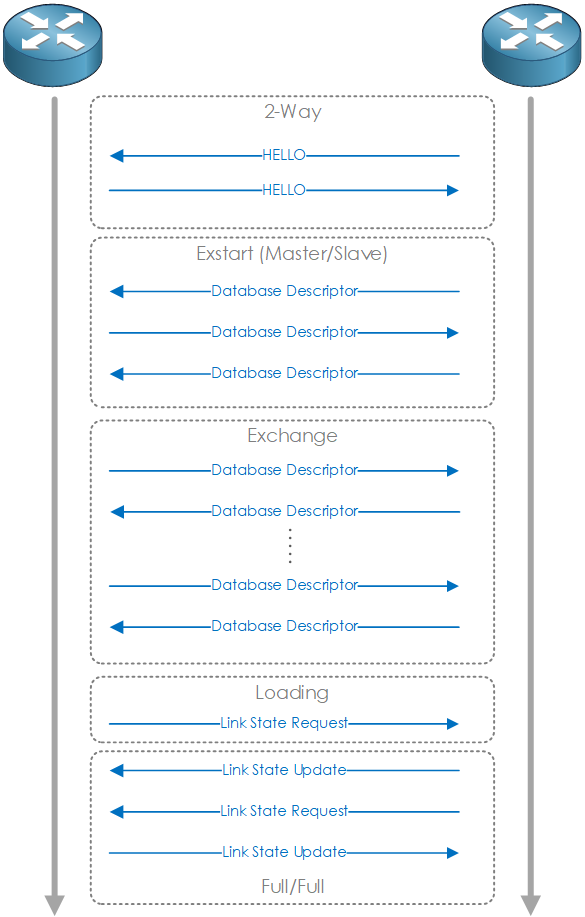Introduction
Within this article we will look at a Cisco feature called EIGRP named mode. As this involves IPv6 we will also provide an overview of IPv6 in EIGRP, whilst also providing a configuration example.
The Problem
Though EIGRP supports both IPv4 and IPv6, the configuration methods for both differ.
For example IPv6 is configured within the interface configuration, along with both EIGRP modes have their own config modes. This can result in needing to switch between config modes and also the EIGRP config being spread throughout the devices config.
EIGRP Named Mode
Cisco's answer to this is EIGRP named mode. This centralized the EIGRP configuration for both IPv4 and IPv6 within a EIGRP virtual instance.
Within EIGRP named mode (i.e the virtual instance) there are address-families configuration modes. Such as :
- address-family configuration mode - Either IPv4 or IPv6. Used to configure the router-id or set the router as a stub router.
- address-family-interface configuration mode - Interface specific commands. Such as setting the interface as a passive interface, or setting the timers.
- address-family-topology configuration mode - Configuration that directly affects the topology table of EIGRP. Such as setting the variance or setting redistribution.
Note: EIGRP mode only changes the organization of the configuration, the underlying EIGRP operation remains the same. For example, a device running EIGRP named mode can fully interoperate with another device running a non-named mode EIGRP configuration.
IPv6
Though this is an article about EIGRP named mode, there are a few difference between EIGRP IPv6 and EIGRP IPv4, which are worth a mention. Such as:
- The link-local address is used as the next-hop within each route.
- There is no auto-summarization.
- Neighbors do not need to be on the same subnet.
- Updates are sent to the IPv6 multicast address of FF02::A.
Configuration Example
Our configuration example will be based on:
- 2 x Cisco IOS routers - R1 and R2.
- R1 will be configured with EIGRP IPv4 and IPv6 via EIGRP standard mode.
- R2 will be configured with EIGRP IPv4 and IPv6 via EIGRP named mode.
- IPv4 Configuration will contain:
- Selecting the EIGRP interfaces, but setting all to passive then enabling EIGRP on a per-interface basis.
- Setting the hold time and hello time on the EIGRP interface
- Configuring the variance for Unequal ECMP
- IPv6 Configuration will contain:
- Configuring the variance for Unequal ECMP

Figure 1 - Basic Topology.
R1 Configuration - Standard
IPv4
R1(config)#router eigrp 1
R1(config-router)# network 0.0.0.0
R1(config-router)# passive-interface default
R1(config-router)# no passive-interface gi0/2
R1(config-router)# variance 2
R1(config-router)# exit
R1(config)# interface GigabitEthernet0/2
R1(config-if)# ip hello-interval eigrp 1 2
R1(config-if)# ip hold-time eigrp 1 10
IPv6
R1(config)# ipv6 router eigrp 2
R1(config-rtr)# variance 2
R1(config)#int gi0/1
R1(config-if)#ipv6 eigrp 2
R1(config-if)#int gi0/2
R1(config-if)#ipv6 eigrp 2
R1(config-if)#int lo1
R1(config-if)#ipv6 eigrp 2
R2 Configuration - Named Mode
Lets step through the steps required to configure EIGRP via named mode.
Create Instance
R2(config-router)#router eigrp EIGRP-NAMED
IPv4
R2(config-router)# address-family ipv4 unicast autonomous-system 1
R2(config-router-af)# af-interface default
R2(config-router-af-interface)# hello-interval 2
R2(config-router-af-interface)# hold-time 10
R2(config-router-af-interface)# passive-interface
R2(config-router-af-interface)# exit-af-interface
R2(config-router-af)# af-interface GigabitEthernet0/1
R2(config-router-af-interface)# no passive-interface
R2(config-router-af-interface)# exit-af-interface
R2(config-router-af)# topology base
R2(config-router-af-topology)# variance 2
R2(config-router-af-topology)# exit-af-topology
R2(config-router-af)# network 0.0.0.0
R2(config-router-af)# exit-address-family
IPv6
R2(config-router)# address-family ipv6 unicast autonomous-system 2
R2(config-router-af)# topology base
R2(config-router-af-topology)# variance 2
R2(config-router-af-topology)# exit-af-topology
R2(config-router-af)# exit-address-family
Verification
We can now validate EIGRP is working as expected by inspecting the following commands,
R1
IPv4
R1#show ip route eigrp
Codes: L - local, C - connected, S - static, R - RIP, M - mobile, B - BGP
D - EIGRP, EX - EIGRP external, O - OSPF, IA - OSPF inter area
N1 - OSPF NSSA external type 1, N2 - OSPF NSSA external type 2
E1 - OSPF external type 1, E2 - OSPF external type 2
i - IS-IS, su - IS-IS summary, L1 - IS-IS level-1, L2 - IS-IS level-2
ia - IS-IS inter area, * - candidate default, U - per-user static route
o - ODR, P - periodic downloaded static route, H - NHRP, l - LISP
a - application route
+ - replicated route, % - next hop override, p - overrides from PfR
Gateway of last resort is not set
2.0.0.0/32 is subnetted, 1 subnets
D 2.2.2.2 [90/2848] via 10.0.0.14, 00:23:16, GigabitEthernet0/2
10.0.0.0/8 is variably subnetted, 5 subnets, 2 masks
D 10.0.0.8/30 [90/3072] via 10.0.0.14, 00:23:16, GigabitEthernet0/2
IPv6
R1#show ipv6 route eigrp
IPv6 Routing Table - default - 8 entries
Codes: C - Connected, L - Local, S - Static, U - Per-user Static route
B - BGP, HA - Home Agent, MR - Mobile Router, R - RIP
H - NHRP, I1 - ISIS L1, I2 - ISIS L2, IA - ISIS interarea
IS - ISIS summary, D - EIGRP, EX - EIGRP external, NM - NEMO
ND - ND Default, NDp - ND Prefix, DCE - Destination, NDr - Redirect
RL - RPL, O - OSPF Intra, OI - OSPF Inter, OE1 - OSPF ext 1
OE2 - OSPF ext 2, ON1 - OSPF NSSA ext 1, ON2 - OSPF NSSA ext 2
la - LISP alt, lr - LISP site-registrations, ld - LISP dyn-eid
lA - LISP away, a - Application
D 2001:DB8:A:0:1:3::/96 [90/3072]
via FE80::F816:3EFF:FE32:DB28, GigabitEthernet0/2
D 2001:DB8:B:0:1::3/128 [90/2848]
via FE80::F816:3EFF:FE32:DB28, GigabitEthernet0/2
R2
IPv4
R2#show ip route eigrp
Codes: L - local, C - connected, S - static, R - RIP, M - mobile, B - BGP
D - EIGRP, EX - EIGRP external, O - OSPF, IA - OSPF inter area
N1 - OSPF NSSA external type 1, N2 - OSPF NSSA external type 2
E1 - OSPF external type 1, E2 - OSPF external type 2
i - IS-IS, su - IS-IS summary, L1 - IS-IS level-1, L2 - IS-IS level-2
ia - IS-IS inter area, * - candidate default, U - per-user static route
o - ODR, P - periodic downloaded static route, H - NHRP, l - LISP
a - application route
+ - replicated route, % - next hop override, p - overrides from PfR
Gateway of last resort is not set
1.0.0.0/32 is subnetted, 1 subnets
D 1.1.1.1 [90/2570240] via 10.0.0.13, 00:21:46, GigabitEthernet0/1
10.0.0.0/8 is variably subnetted, 5 subnets, 2 masks
D 10.0.0.4/30 [90/15360] via 10.0.0.13, 00:21:46, GigabitEthernet0/1
IPv6
R2#show ipv6 route eigrp
IPv6 Routing Table - default - 7 entries
Codes: C - Connected, L - Local, S - Static, U - Per-user Static route
B - BGP, HA - Home Agent, MR - Mobile Router, R - RIP
H - NHRP, I1 - ISIS L1, I2 - ISIS L2, IA - ISIS interarea
IS - ISIS summary, D - EIGRP, EX - EIGRP external, NM - NEMO
ND - ND Default, NDp - ND Prefix, DCE - Destination, NDr - Redirect
RL - RPL, O - OSPF Intra, OI - OSPF Inter, OE1 - OSPF ext 1
OE2 - OSPF ext 2, ON1 - OSPF NSSA ext 1, ON2 - OSPF NSSA ext 2
la - LISP alt, lr - LISP site-registrations, ld - LISP dyn-eid
lA - LISP away, a - Application
D 2001:DB8:A:0:1:2::/96 [90/15360]
via FE80::F816:3EFF:FE18:3D06, GigabitEthernet0/1
Additional commands
Some additional commands that may help in troubleshooting are found below:
IPv4
| Command | Description |
|---|---|
| show ip protocols | Display details around the EIGRP protocol (includes K values) |
| show ip eigrp neighbors | Display EIGRP neighbors |
| show ip eigrp interfaces | Display EIGRP interfaces |
| show ip eigrp interfaces detail | Display EIGRP interfaces in detail (includes timers) |
IPv6
| Command | Description |
|---|---|
| show ipv6 protocols | Display details around the EIGRP protocol (includes K values) |
| show ipv6 eigrp neighbors | Display EIGRP neighbors |
| show ipv6 eigrp interfaces | Display EIGRP interfaces |
| show ipv6 eigrp interfaces detail | Display EIGRP interfaces in detail (includes timers) |







